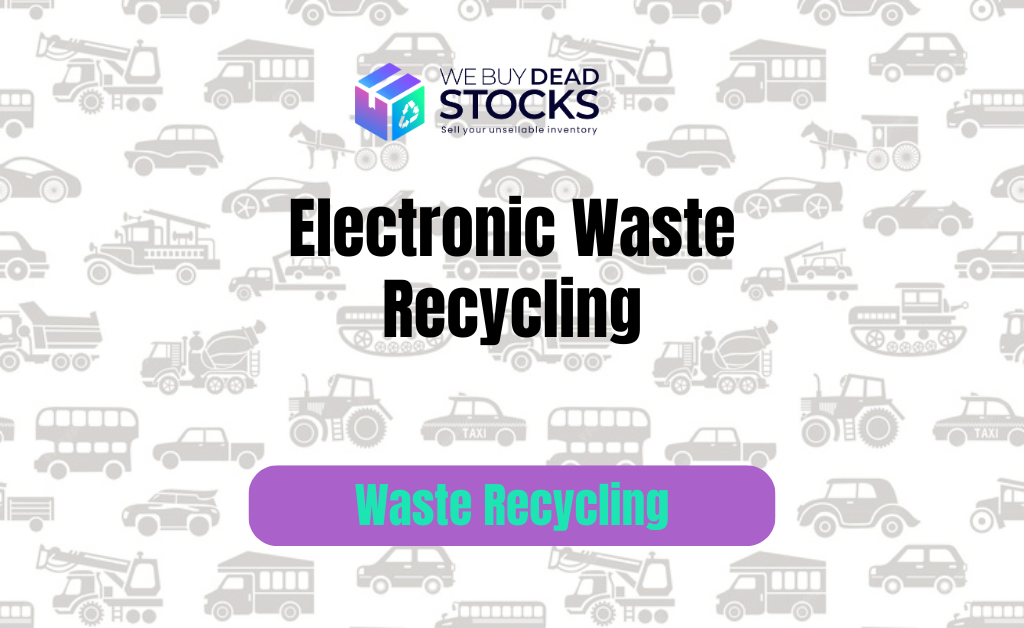As the world becomes increasingly digitised, the accumulation of electronic devices continues to surge, consequently heightening concerns about environmental sustainability and resource depletion. However, amidst these challenges lies a promising opportunity: electronic waste recycling. In this article, we’ll explore the various avenues through which electronic waste recycling can not only mitigate environmental harm but also serve as a lucrative venture in the current landscape.
Delving into Electronic Waste Recycling
Electronic waste, commonly known as e-waste, encompasses discarded electronic devices such as smartphones, laptops, televisions, and other gadgets. These items, when improperly disposed of, contribute significantly to environmental pollution due to their hazardous components like lead, mercury, and cadmium.
Processes Involved in Electronic Waste Recycling
- Collection and Sorting: The first step in electronic waste recycling involves collecting discarded devices and sorting them based on their type, condition, and recyclability. This phase often occurs at recycling centres or specialised facilities.
- Disassembly and Component Salvaging: Once sorted, the devices undergo disassembly, where trained technicians carefully dismantle them to extract reusable components. Usable parts like batteries, screens, and circuit boards are salvaged for potential reuse or refurbishment.
- Material Extraction: After disassembly, the devices undergo further processing to extract valuable materials such as metals (e.g., copper, gold, silver) and plastics. Specialised techniques like shredding, crushing, and melting are employed to separate these materials efficiently.
- Recycling and Refinement: Extracted metals and plastics are then recycled through various methods including excess inventory liquidation. Metals undergo purification processes to remove impurities, while plastics are melted and reprocessed into new raw materials for manufacturing.
- Safe Disposal of Hazardous Components: Any remaining hazardous materials, such as batteries and mercury-containing components, are disposed of safely to prevent environmental contamination. Proper disposal methods ensure that these substances do not leach into soil or water sources.
Importance of Responsible E-waste Management
- Environmental Protection: Responsible e-waste recyling process management helps prevent environmental pollution by reducing the release of toxic substances into the environment. This protects ecosystems, wildlife, and human health from harm.
- Resource Conservation: To recycle electronic waste helps conserve valuable resources by recovering materials like metals and plastics, which can be reused in manufacturing processes. This reduces the need for extracting raw materials from the earth, minimising energy consumption and greenhouse gas emissions.
- Promotion of Circular Economy: E-waste recycling promotes a circular economy by extending the lifespan of electronic devices and their components. Reusing and recycling materials contribute to a sustainable approach to resource management and waste reduction.
Financial Incentives of Electronic Waste Recycling
Economic Value of E-waste Components
- Precious Metals: Electronic devices contain precious metals such as gold, silver, and copper, which have significant economic value. To recycle electronic waste metals reduces the need for costly mining operations and conserves natural resources.
- Plastics and Other Materials: Beyond metals, e-waste also contains recyclable materials like plastics, glass, and rare earth elements. Recycling these components reduces manufacturing costs by providing a sustainable source of raw materials.
Revenue Streams from Refurbished Electronics
- Resale Value: Refurbished electronics, including smartphones, laptops, and tablets, have a thriving market. By refurbishing and excess inventory liquidation, recyclers can generate substantial revenue while extending the lifespan of products and reducing electronic waste.
- Component Sales: Salvaged components from electronic waste, such as screens, batteries, and circuit boards, can be sold to manufacturers for use in new products or repairs. This creates additional revenue streams for recyclers while promoting a circular economy.
Government Incentives and Policies Supporting E-waste Recycling
- Financial Incentives: Many governments offer financial incentives, such as tax credits or subsidies, to encourage e-waste recycling process initiatives. These incentives help offset the costs associated with collection, processing, and recycling, making it more economically viable for businesses and consumers.
- Regulatory Requirements: Governments worldwide have implemented regulations and policies mandating the proper disposal and recycling of electronic waste. Compliance with these regulations not only ensures environmental protection but also opens up opportunities for financial support and partnerships.
Cost Savings from Reduced Raw Material Extraction and Energy Consumption
- Raw Material Savings: By recycling e-waste and recovering valuable materials, manufacturers can reduce their reliance on virgin resources, thereby lowering procurement costs and mitigating price volatility in commodity markets.
- Energy Efficiency: Electronic waste recycling consumes less energy compared to extracting and processing raw materials from ores. This energy savings translates into cost savings for businesses involved in the manufacturing and recycling sectors.
Environmental Benefits Leading to Financial Gain
- Sustainability Drives Profits: When companies make eco-friendly choices, they often find they make more money in the long run.
- Corporate Responsibility Boosts Brands: Being good to the planet improves how people see a company, which makes customers more likely to stick around and buy more stuff.
- Cost Savings Over Time: By being careful about not damaging the environment, businesses can save money in the future.
- Resource Conservation Saves Money: When we reuse things like metals from old electronics, we don’t have to buy as much new stuff, which means we spend less.
- Less Energy Use, Lower Bills: Using less energy helps save money on things like electricity bills.
- Avoiding Environmental Problems: If companies don’t hurt the environment, they won’t have to pay fines or deal with other problems that could cost them a lot of money.
- Customers Want Eco-Friendly Brands: People like buying from companies that care about the environment, so businesses that do often make more sales.
- New Markets with Green Tech: Creating and selling eco-friendly products can open up new markets and ways to make money for smart businesses.
- Investing in Green Ideas: Putting money into things like solar power or recycling can make a company more money in the future while also helping the environment.
- Building a Better Tomorrow: Ultimately, being kind to the environment isn’t just good for business—it’s good for everyone, and it can help make the world a better place for future generations.
Conclusion
In conclusion, electronic waste recycling presents a multifaceted opportunity for financial gain in 2024. As our world embraces digitalization, the accumulation of electronic devices raises concerns about sustainability and resource depletion. However, within this challenge lies a promising solution: e-waste recycling. By delving into the processes involved in electronic waste recycling, we uncover not only environmental benefits but also significant financial incentives. From extracting valuable metals to refurbishing and reselling electronics, there are numerous revenue streams waiting to be tapped into. Moreover, government incentives and regulations further bolster the financial viability of e-waste recycling initiatives.
In essence, electronic waste recycling offers a win-win scenario: it not only contributes to a cleaner, healthier planet but also presents lucrative opportunities for financial growth. By recognizing the link between environmental sustainability and financial profitability, businesses can pave the way for a more sustainable and prosperous future in 2024 and beyond.





